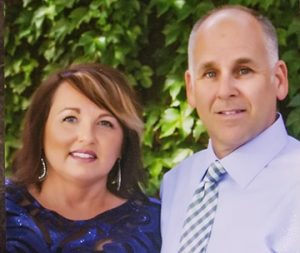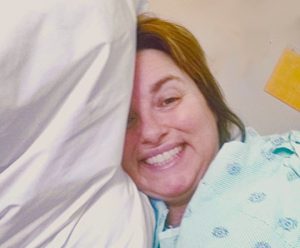When I first looked into the Transcendental Meditation® (TM®) technique several years ago, I thought I was looking into it for my children. I had no idea it would one day help save my life.
My husband Tim and I adopted two children with special needs who had a lot of anger and adjustment issues. Sarah and Andrew were 3 and 7 when they came into our lives, and now they’re 19 and 23 and thriving.

Cin and Tim Langston
During their early teens, I thought learning the TM technique might help ease their anger and growing pains. We couldn’t afford the course then,* but I never forgot about the idea of learning TM.
Starting to Heal
In September 2014, I finally took the TM course.
My life, my mind, and my health had been deteriorating over the years from the stress of my home and work situations. Even though I could not afford TM instruction for all three of us, I felt I needed it for me so I would be best prepared to help everyone else.
I loved how my TM practice made me feel. I was 100 percent confident that it was going to help me heal any damage that had been done, as well as help me fight off future problems, both physical and mental.
At the time, I had been battling massive kidney stones and had just started seeing a cardiologist for some weird, unexplained heartbeat activity.
I loved how my TM practice made me feel. I was 100 percent confident that it was going to help me heal any damage…
Coming Back to Life
Then, in February 2016, I went into cardiac arrest at work. My heart stopped, and I was gone for several minutes, with no oxygen to my brain. I was 47.
The emergency medical team could not get a pulse. Fortunately, the sheriff showed up with paddles, or life-saving defibrillator, and was able to get a slight pulse. They rushed me to McLaren Hospital in nearby Flint, Michigan, and lowered my body temperature to put me into a coma, in hopes of minimizing the brain damage.
Even so, after I had been in the medically induced coma for a few days, the doctor told my husband that he should not get his hopes up. The doctor said that even if I were able to breathe on my own once I came off life support, the brain damage was likely to be too severe for any quality of life.

Cin took a selfie after coming out of the coma
Despite this dire prognosis, when I came out of the coma, everyone was encouraged by my ability to answer questions.
I was fidgety, so the doctor told me that if I could lay still for 20 minutes, he would unhook me from all the tubes. It was then that I wrote “TM” on a piece of paper.
My husband and best friend knew what that meant, so they shut the lights off and asked everyone to leave so that I could meditate.
After 20 minutes, the doctor returned, removed the tubes, and I was breathing on my own. Two and a half years later, here I am, better than ever, except for some memory gaps here and there.
It was then that I wrote “TM” on a piece of paper…
Meditating Took Care of Me
Now, most of this story is of things that have been told to me. I don’t have any memory of the event or the time shortly before it.
What I do remember is that at some point in the middle of it all, I saw in my mind the face of my TM instructor Linda Simmons. I heard her voice during the TM course, telling us to practice Transcendental Meditation for 20 minutes twice a day, unless we are sick in bed or in the hospital. Then we can meditate as much as is comfortable to facilitate healing.
That memory, plus my husband’s report that I wanted to meditate as soon as I came out of the coma, makes me feel that the growth of consciousness from meditating for a year and a half sustained me and allowed my conscious awareness to bounce back quickly from the coma.
I don’t think I would have survived the cardiac arrest with such minimal damage to my brain if I hadn’t taken the leap and learned TM, and I will continue my practice. I am also so thankful for the amazing medical team who took care of me, and the prayers of loved ones.
I don’t think I would have survived the cardiac arrest with such minimal damage to my brain if I hadn’t taken the leap and learned TM.
Sharing This Gift
My life is as full as ever. A few months after I got out of the hospital, my daughter Sarah and I took a spontaneous drive up the west side of Michigan to enjoy the scenic view along Lake Michigan. The banner picture above is us at a scenic lookout at the end of many, many flights of stairs. This was a milestone for me, as my activity level was still low and on the mend.

Cin and her son Andrew at her daughter Sarah’s high school graduation in June, 2018
A recent highlight was Sarah’s graduation from high school last June, where this picture with my son Andrew was taken. He has a great job, and Sarah is preparing for art school in New York City.
Now I have been trying to figure out how to make meditation the main focus of my life, and I’m considering becoming a certified teacher of the Transcendental Meditation technique.
I am so grateful for the TM technique, I just want to spread this gift as far as I can.
I am so grateful for the TM technique, I just want to spread this gift as far as I can.
Cin Langston is a mortgage assistant and Arbonne team builder who lives in Burton, Michigan with her husband Tim and their children, Andrew and Sarah.
*Note: Almost all U.S. TM Centers now have a scholarship program to help those in financial need.
Editor’s Note: The effects of the TM technique, if any, on recovery after a medically induced coma have not been scientifically established. However, a study of veterans with post traumatic stress and brain trauma, published in the journal Military Medicine, showed that “regular practice of Transcendental Meditation provides a habit of calming down and healing the brain,” said Dr. Vernon A. Barnes, a physiologist at the Georgia Prevention Institute at the Medical College of Georgia, Augusta University. Barnes, the study’s lead author, teaches the TM technique at the Dwight David Eisenhower Army Medical Center’s Traumatic Brain Injury Clinic at Fort Gordon, Georgia. Read more about this study ►
Disclaimer: Our intention is to provide general educational information. The information in this article is not intended to be personal medical advice, nor should it be used as a substitute for medical advice, diagnosis, or treatment.


Comments
you MAY ALSO LIKE
My Story
My New and Improved Brain
Jessica Hatchette shares how TM helped her recover from a traumatic injury: "I'm better today than I was before I started TM. In addition to getting my old brain function back, I'm more kind, patient, resilient, present, calm, and compassionate."
My Story
A Journey from Brain Injury to Brain Health
Author and university professor William T. Hathaway describes how TM supported his brain health and gave him access to his talent and mental abilities: "In a few weeks my thoughts became clearer, and I didn't want drugs anymore. I could concentrate. And I could write..." (Read more)
Better Health
A Gift for Myself: Recovering from Lyme
"I am a year into my TM practice, and nearly all of the Lyme symptoms are gone," writes Donna Faulkner. "Now I’m enjoying the other benefits of the practice, such as joy-filled days of creativity, energy, purposefulness, and peacefulness."
Science & Research
How Transcending Optimizes Your Brain
What happens to our brains when we transcend? Do we experience a new state of consciousness? How does that help us realize our highest potential? In part 3 of his popular series, Dr. David Orme-Johnson tells the story of the revolutionary TM research that advanced the science of human potential.